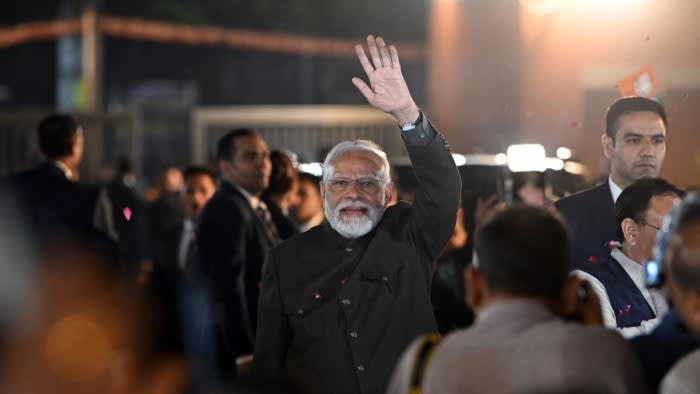Unlock the Editor’s Digest for free
Roula Khalaf, Editor of the FT, selects her favourite stories in this weekly newsletter.
The writer is chair of Rockefeller International
Though Indian Prime Minister Narendra Modi is in his 10th year in office, his position is as strong as ever. The Bharatiya Janata party’s overwhelming election victories in the Hindi heartland states confirm Modi’s grip on the world’s largest democracy, as well as the shadow he casts over its hapless opposition.
Ahead of Sunday’s results, the opposition had hoped to build on its gains following the Congress party’s win in the state of Karnataka earlier this year. The BJP and its allies still ruled in states representing 45 per cent of the national population, but that was down from 70 per cent at their peak just six years ago. Modi took it upon himself to reverse that decline. The BJP campaigned as if he were the candidate for chief minister in contested states, featuring his image on posters, relegating the actual candidates to the background.
Modi fights these battles because they matter so much in India, where 60 per cent of government spending is carried out by the states in India, compared with 30 per cent on average in developed countries.
The BJP won three of the four contested states, and now with its allies controls 16 of the 29 states, representing nearly 60 per cent of the population. Though state elections have of late not been good leading indicators of national elections, it is hard to see the BJP losing next May’s national ballot. When Modi was the prime ministerial candidate in 2019, he led his party to a margin of victory 10 points higher than its average in state election victories since then.
Meanwhile, Congress lost the states of Rajasthan and Chhattisgarh to the BJP, extending an unusual string of failures. Dropping a longstanding tendency to toss out incumbents, voters began in recent years to re-elect most chief ministers — but only from the BJP and regional parties. No Congress chief minister has won re-election since 2014. Dominated by the dynastic Gandhi family, Congress doesn’t have the entrepreneurial drive of Modi and many regional leaders.

Even the one contest that Congress won, in the southern state of Telangana, simultaneously illuminates Modi’s drawing power. Carved out in 2014, Telangana is the newest state in the country. It has seen extraordinary progress under Bharat Rashtra Samithi, the regional party that led it to independence, climbing the ranks from 15th to third richest state. Nine of its 10 districts were officially classified as poor and “backward” in 2014. Today, none are.
When I travelled there to cover the election, far from the high-tech hub and state capital of Hyderabad, I encountered villagers raising fat turkeys — a pricey breed of poultry once unknown in the Indian back-country. Many homes were newly remodelled, in concrete with glass windows rather than mud or clay. Outside one, a woman was taking delivery of a new dress from a scooter driver, who told me customers order from his employer online — and can return goods the same way. Such conveniences were rare in villages even five years ago.
Nonetheless, people in Telangana wanted change and the Congress offered an unusually young and dynamic challenger, Revanth Reddy. Voters told me that 10 years in power was enough for BRS chief minister K Chandrashekar Rao and complained of his shortcomings. When conversation turned to Modi, they saw only accomplishments and a leader enhancing India’s global stature. One voter even cited the recent assassination of a Sikh separatist leader in Canada — for which Modi’s government adamantly denies responsibility — as proof, in their view, that he can get things done outside the country as well.
Still, if there is a chink in Modi’s armour, it is in the five southern states, now including Telangana. These states lost ground to the north in the 2000s but regained momentum in the last decade, when their share of national economic output rose from 25 per cent to 30 per cent, even as their share of the population slipped a bit to 20 per cent. Southern politicians claim credit for driving national growth and stir resentment against the BJP, which they accuse of taxing the south to fund welfare in the north.
India is more a continent than a country. What works in one region won’t always work in another. But then it doesn’t need to. In the Hindi heartland, which has enough votes to return Modi to power, his brand of Hindu nationalism, carefully crafted image of managerial competence, and powerful party organisation still mobilise enormous support. With no coherent opposition to rally the other regions against him, Modi looks to be cruising to a third term.
